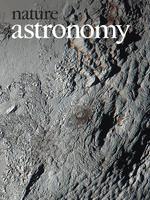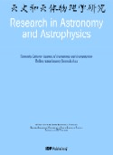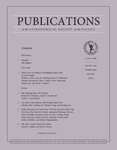
Galaxies
Scope & Guideline
Connecting researchers across the cosmic frontier.
Introduction
Aims and Scopes
- Astrophysical Processes in Galaxies:
Research on the physical processes occurring within galaxies, including star formation, black hole accretion, and feedback mechanisms from active galactic nuclei (AGN). - Cosmology and Dark Matter:
Studies that investigate the structure and evolution of the universe, including the role of dark matter, cosmic expansion, and the Hubble constant. - High-Energy Astrophysics:
Explorations of high-energy phenomena such as gamma-ray bursts, X-ray emissions from stellar objects, and the dynamics of relativistic jets. - Polarimetry and Spectroscopy:
Utilization of polarimetric and spectroscopic techniques to study the magnetic fields, dynamics, and composition of astrophysical objects. - Multi-Messenger Astronomy:
Integration of various observational techniques, including gravitational waves, electromagnetic observations, and neutrino detections to provide a comprehensive understanding of cosmic events. - Exoplanetary Science:
Research on the formation and characterization of exoplanets, including their atmospheres, habitability, and the dynamics of their host systems. - Astrochemistry and Molecular Gas Dynamics:
Investigations into the chemical processes and molecular gas dynamics in star-forming regions and the interstellar medium.
Trending and Emerging
- Multi-Messenger Astronomy:
There is a growing focus on combining data from gravitational waves, electromagnetic observations, and neutrinos to create a holistic understanding of cosmic events, exemplified by the integration of these modalities in recent publications. - Advanced Polarimetry Techniques:
Emerging research on advanced polarimetric techniques and their application in understanding the magnetic fields and dynamics of astrophysical jets and accretion disks is on the rise. - Astrobiology and Habitability of Exoplanets:
Increased interest in astrobiology, specifically the study of exoplanets and their potential habitability, is reflected in recent papers analyzing the conditions for life beyond Earth. - High-Redshift Galaxy Studies:
Research targeting high-redshift galaxies is trending, focusing on the early universe's properties, galaxy formation, and evolution during critical epochs. - Machine Learning and Big Data in Astronomy:
The application of machine learning techniques to process and analyze vast astronomical datasets is becoming increasingly prominent, enhancing research capabilities in various astrophysical domains. - Astrochemistry in Galactic Environments:
Emerging studies on the role of astrochemistry in the formation and evolution of galaxies, particularly in star-forming regions and molecular clouds, are gaining traction.
Declining or Waning
- Traditional Stellar Evolution Models:
Research related to standard stellar evolution models has decreased as newer methods and simulations, such as those considering advanced physics or multi-dimensional effects, gain prominence. - Static Models of Galaxy Formation:
Studies that employ static models for galaxy formation are becoming less frequent, as dynamic and interactive simulations are preferred for their ability to incorporate complex gravitational interactions and feedback. - Single-Wavelength Observations:
The emphasis on single-wavelength observations has waned in favor of multi-wavelength approaches that provide a more comprehensive view of astronomical phenomena. - Basic Theoretical Frameworks:
There is a noticeable decline in publications focusing solely on basic theoretical frameworks without application to specific astrophysical problems, as more applied research takes precedence. - Classical Surveys without Deep Learning Integration:
Research that does not incorporate modern data analysis techniques, such as machine learning and AI, is becoming less common as the field moves towards more sophisticated data processing methodologies.
Similar Journals

Physics of the Dark Universe
Navigating the Unseen Realms of the UniversePhysics of the Dark Universe is a premier academic journal published by Elsevier, dedicated to advancing the understanding of dark matter, dark energy, and their implications for the universe. With its ISSN N/A and E-ISSN 2212-6864, the journal has established a notable presence since its inception in 2012, operating out of Amsterdam, Netherlands. As evidenced by its impressive impact factor and its ranking in the top quartile in both Astronomy and Astrophysics (Q1) and Space and Planetary Science (Q1) categories for 2023, this journal is a vital resource for researchers and practitioners within these fields. In the latest Scopus ranks, it ranks #12 out of 104 in Earth and Planetary Sciences and #13 out of 90 in Physics and Astronomy, placing it in the 88th and 86th percentiles respectively, underlining its academic significance. The journal is not Open Access, yet it plays an essential role in disseminating high-quality research that pushes the boundaries of knowledge about the cosmos and its most enigmatic components. Researchers, professionals, and students interested in the forefront of astrophysics will find this journal an indispensable tool for staying abreast of emerging discoveries and ongoing debates.

ASTROPHYSICS
Shaping the Future: Essential Research in Astronomy and AstrophysicsASTROPHYSICS, published by Springer/Plenum Publishers, stands as a crucial platform for the dissemination of groundbreaking research in the field of Astronomy and Astrophysics. Established in 1965 and continuing its legacy until 2024, the journal highlights significant advancements, theoretical frameworks, and observational data that collectively push the boundaries of our understanding of the universe. Although currently categorized in the Q4 quartile for Astronomy and Astrophysics and holding a Scopus rank within the 17th percentile, ASTROPHYSICS remains dedicated to offering rigorous peer-reviewed content that is essential for researchers, professionals, and students alike. While it does not provide open access, the journal's accessibility through institutional subscriptions ensures a wide reach among the academic community, allowing it to address the rising curiosity surrounding cosmic phenomena and contribute meaningfully to ongoing scholarly discourse. For those seeking to engage with the latest findings and methodologies in astrophysics, ASTROPHYSICS continues to serve as an indispensable resource.

Contributions of the Astronomical Observatory Skalnate Pleso
Illuminating the Heavens: A Platform for Astronomical InnovationContributions of the Astronomical Observatory Skalnate Pleso, published by the Slovak Academy of Sciences Astronomical Institute, serves as a vital platform for the dissemination of research in the realm of Astronomy and Astrophysics. With its ISSN number 1335-1842 and E-ISSN 1336-0337, this esteemed journal aims to foster scientific discourse and innovation among researchers, professionals, and students alike. Although it currently holds a Q4 quartile ranking in its field as of 2023, the journal encourages contributions that enhance our understanding of universe dynamics and celestial phenomena through rigorous research methodologies. Spanning from its inaugural year in 2007 to the projected continuation through 2024, it integrates local insights from Slovakia with broader international endeavors in astronomy. The journal promotes an open-access approach, providing scholars unrestricted access to valuable findings and discussions, thereby advancing the boundaries of astronomical knowledge.

Nature Astronomy
Shaping the Future of Astrophysics: Discover, Learn, and Inspire.Nature Astronomy, published by NATURE PORTFOLIO, stands at the forefront of the field of Astronomy and Astrophysics. Since its inception in 2016, this esteemed journal has rapidly ascended to a prestigious position, achieving a Q1 ranking in the Astronomy and Astrophysics category and securing an impressive 6th place out of 90 journals in the Scopus rankings, placing it in the 93rd percentile. With a focus on disseminating pioneering research, Nature Astronomy provides a vital platform for the dissemination of high-quality, impactful findings across various aspects of astronomical science. Researchers, professionals, and students alike will find a wealth of knowledge and innovative perspectives within its pages, enabling them to stay ahead in a rapidly evolving field. Although it does not offer open access, the journal's commitment to excellence and its influence in shaping the future of astronomical research make it an indispensable resource for anyone serious about advancing their understanding of the cosmos.

Journal of the Korean Astronomical Society
Advancing Astronomy: Unveiling the Universe's MysteriesWelcome to the Journal of the Korean Astronomical Society, an esteemed publication dedicated to advancing the fields of Astronomy and Astrophysics as well as Space and Planetary Science. Established in 1993 and under the reputable auspices of the Korean Astronomical Society, this journal serves as a vital platform for researchers and scholars from South Korea and around the globe to disseminate innovative findings and critical insights. With a commendable Q2 ranking in Astronomy and Astrophysics and a Q3 ranking in Space and Planetary Science, this journal is positioned among the influential voices in its fields, fostering collaboration and knowledge exchange. The journal's rigorous peer-review process ensures that published works contribute significantly to ongoing discussions and developments in astronomical research. While currently not an open-access journal, it remains accessible to the academic community, encouraging readers to stay abreast of the latest advancements in the sciences that elucidate the universe's complexities. Join us in exploring the cosmos through cutting-edge research and scholarly discussion that propels the field forward.

NEW ASTRONOMY REVIEWS
Advancing Knowledge: Essential Reviews in Astronomy and AstrophysicsNEW ASTRONOMY REVIEWS, published by Elsevier Science Ltd, stands as a premier journal in the field of Astronomy and Astrophysics as well as Space and Planetary Science. Established in 1998 and operating until 2024, this journal has consistently maintained a distinguished reputation, reflected in its Q1 categorization in both subject areas for 2023. It holds an impressive Scopus ranking, placed #6 out of 104 in Earth and Planetary Sciences and #7 out of 90 in Physics and Astronomy, showcasing its critical impact with a percentile rank of 94th and 92nd, respectively. Although not an open access journal, it provides vital insights and comprehensive reviews that are essential for researchers, professionals, and students eager to advance their knowledge in contemporary astronomical research and theories. With rigorous peer review and a commitment to high-quality publications, NEW ASTRONOMY REVIEWS is an indispensable resource for the scientific community striving to uncover the mysteries of the universe.

Romanian Astronomical Journal
Bridging tradition and innovation in astronomical studies.Welcome to the Romanian Astronomical Journal, a distinguished publication operating under the esteemed EDITURA ACAD ROMANE, dedicated to advancing the field of Astronomy and Astrophysics. With a rich tradition rooted in Romania, this journal aims to foster scholarly discourse and disseminate pivotal research findings within the cosmic sciences. Although currently not designated as Open Access, the journal remains committed to ensuring that its content meets rigorous academic standards. The Romanian Astronomical Journal holds a commendable position in the academic community, achieving a Q3 ranking in Astronomy and Astrophysics and a Q4 ranking in Space and Planetary Science for 2023, reflecting its contribution to the scientific landscape. With a focus on originality and scholarly excellence, this journal serves as a vital resource for researchers, professionals, and students alike, promoting a deeper understanding of the universe and our place within it. Positioned at the intersection of innovative research and practical application, the Romanian Astronomical Journal invites contributions that push the boundaries of knowledge in our field.

Research in Astronomy and Astrophysics
Exploring the Universe, One Discovery at a Time.Research in Astronomy and Astrophysics, published by the National Astronomical Observatories under the Chinese Academy of Sciences, stands out as a pivotal platform for disseminating cutting-edge research in the fields of astronomy and astrophysics. With an ISSN of 1674-4527 and an E-ISSN of 2397-6209, this esteemed journal operates as an open access publication, ensuring that high-quality research is available to a broad audience without any financial barriers. As of 2023, it holds a commendable Q2 quartile ranking in both Astronomy and Astrophysics, as well as Space and Planetary Science, reflecting its importance and revered position among leading journals. Spanning from 2009 to 2024, it is geographically rooted in the United Kingdom but engages a global readership and author base, making significant contributions to the rapidly evolving discourse in astrophysical studies. Moreover, its rankings in Scopus underscore its relevance, ranking 43rd out of 90 in Astronomy and Astrophysics and 61st out of 104 in Space and Planetary Science, placing it firmly within the competitive landscape of scientific research. Research in Astronomy and Astrophysics is dedicated to fostering innovation and communication within the scientific community, offering researchers, professionals, and students alike a valuable resource for collaboration and knowledge advancement.

PUBLICATIONS OF THE ASTRONOMICAL SOCIETY OF THE PACIFIC
Illuminating the Cosmos with Groundbreaking ResearchPublications of the Astronomical Society of the Pacific is a prestigious journal dedicated to advancing the fields of Astronomy and Astrophysics, as well as Space and Planetary Science. Published by IOP Publishing Ltd, this influential journal plays a critical role in disseminating groundbreaking research and innovative findings. With an impressive Q1 ranking in both related categories according to the 2023 metrics, it is recognized among the top journals in its field. As a vital resource for researchers, professionals, and students alike, the journal covers a range of topics relevant to current astronomical research from 1996 to 2024. Although it does not offer open access options, the journal is highly regarded in academic circles, evidenced by its competitive ranking in Scopus—20th in Astronomy and Astrophysics and 26th in Space and Planetary Science. This commitment to excellence ensures that it remains an essential platform for sharing the latest insights in the ever-evolving universe.

Journal of High Energy Astrophysics
Advancing Knowledge: The Frontier of High Energy AstrophysicsThe Journal of High Energy Astrophysics, published by Elsevier, is a premier platform for groundbreaking research in the fields of astrophysics and high-energy phenomena. With an ISSN of 2214-4048 and an E-ISSN of 2214-4056, this journal has quickly established itself as a leader since its inception in 2014. Operating out of the Netherlands, it is recognized for its rigorous peer-review process and high-quality publications, earning an impressive Q1 ranking across multiple domains, including Astronomy and Astrophysics, Nuclear and High Energy Physics, and Space and Planetary Science in 2023. With a Scopus rank of 12 out of 90 in the Astronomy and Astrophysics category, and being positioned in the 87th percentile, the journal plays a pivotal role in disseminating advancements and fostering collaboration among researchers, professionals, and students. Though the journal is not open access, it offers robust subscription options for institutions and individuals seeking to dive into the latest discoveries and theories in high-energy astrophysics.